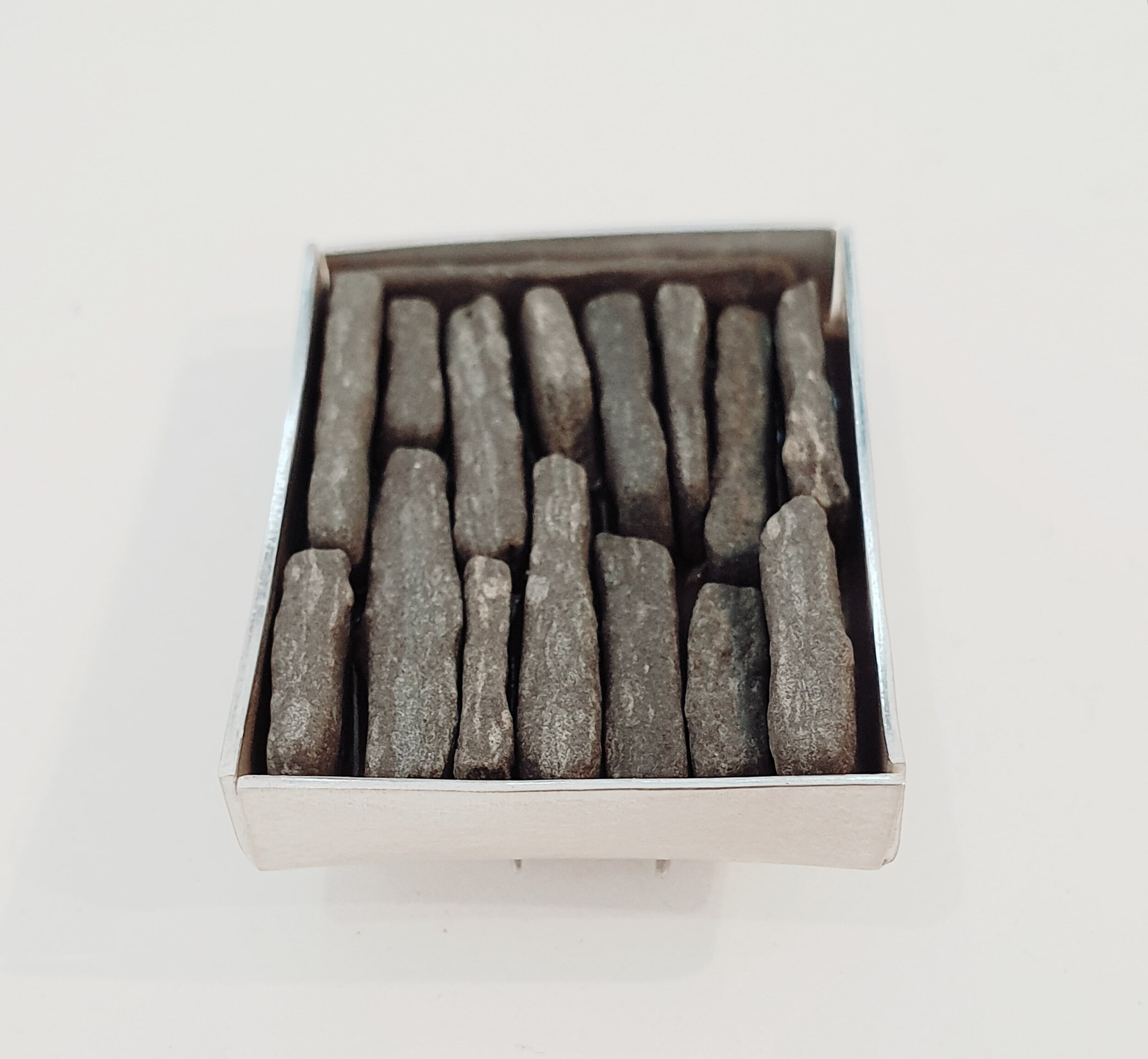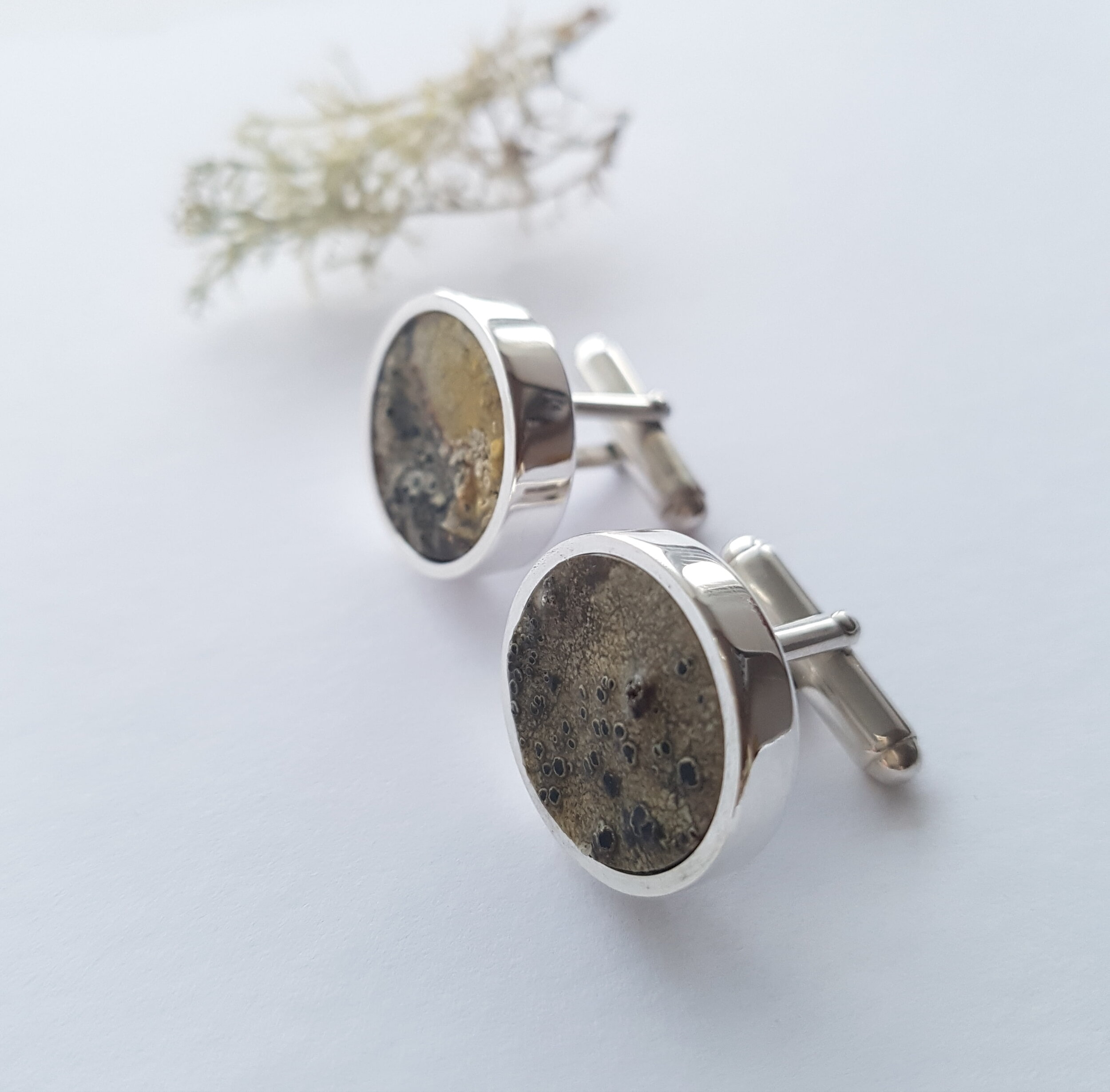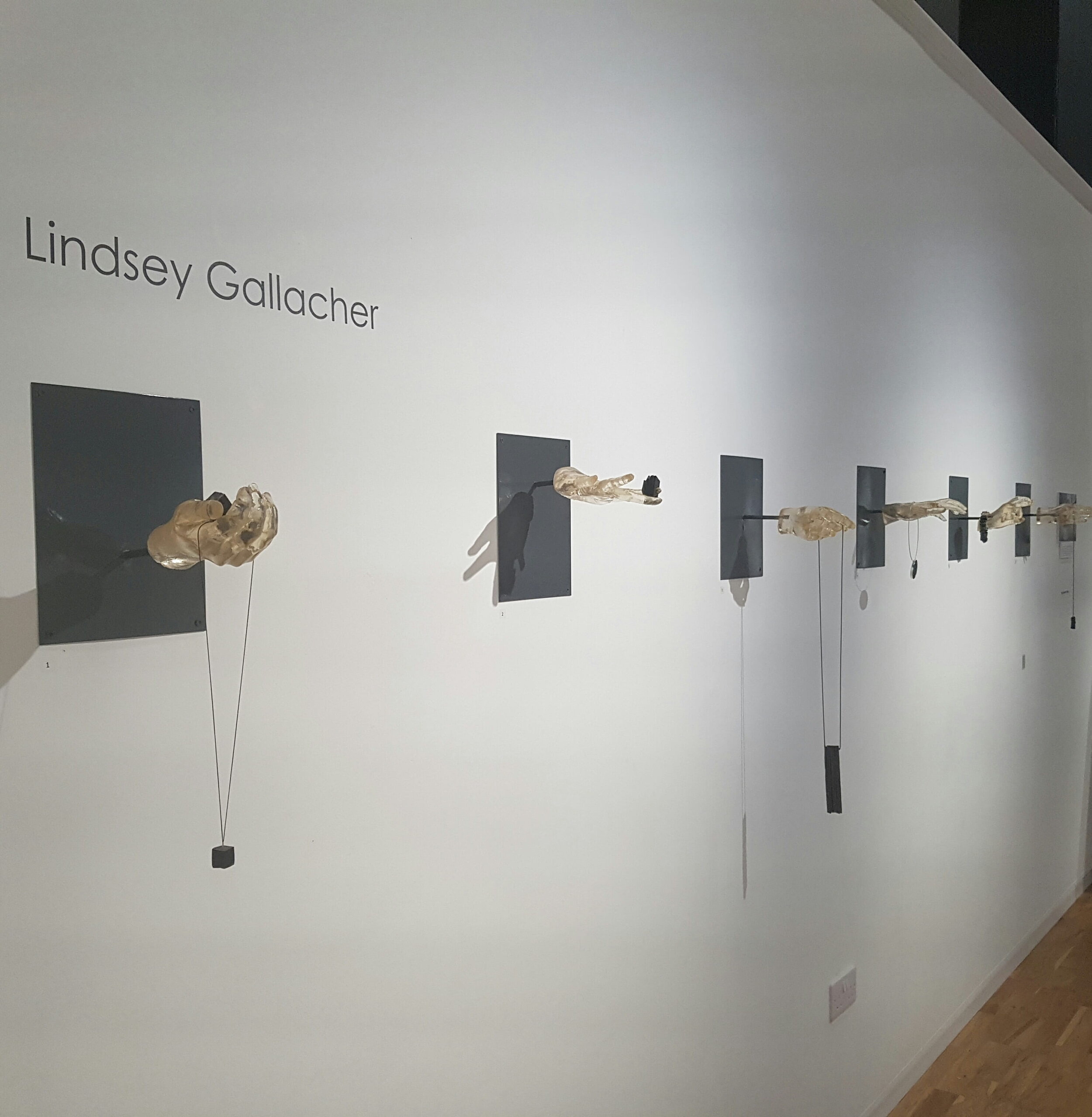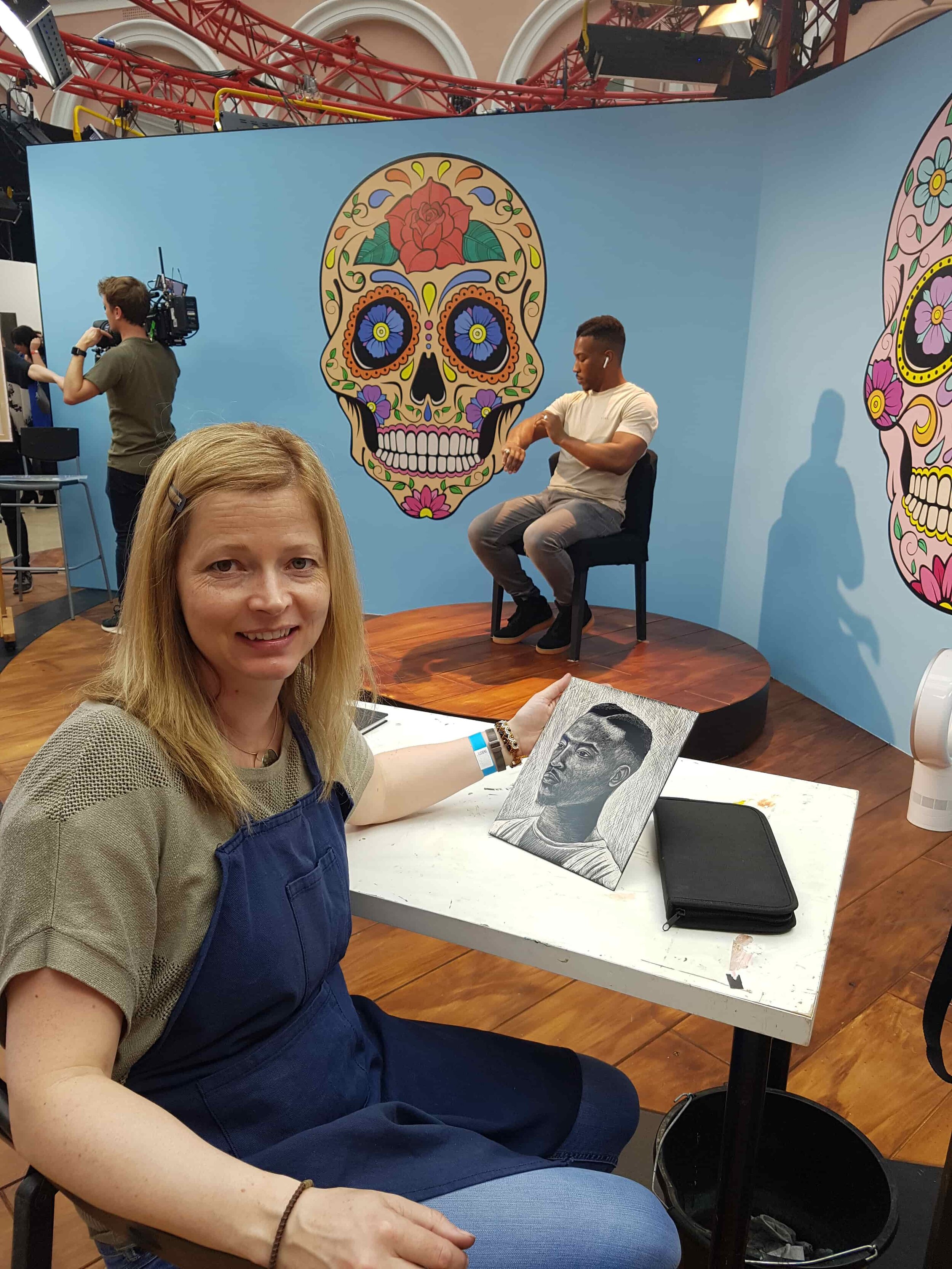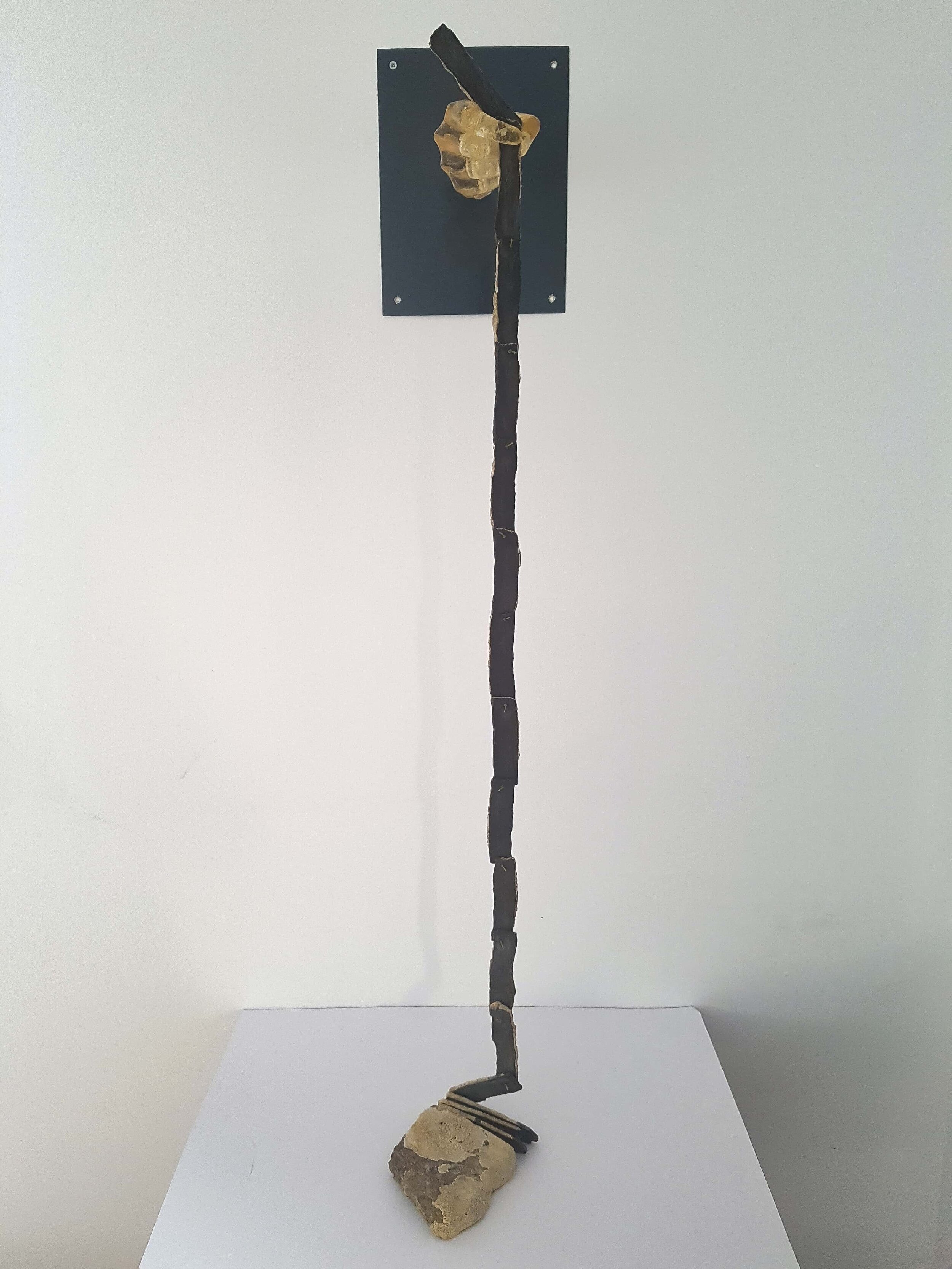Lindsey Gallacher
After returning home to her roots in the far north of Scotland, jeweller Lindsey Gallacher rediscovered her love of the dramatic landscape. She has spent the last six years exploring the qualities of the local Caithness flagstone, successfully incorporating it with precious metal to create both small and delicate jewellery alongside large and dramatic statement pieces. We are delighted to welcome Lindsey for her Elements debut and take you behind-the-scenes for an in-depth look at her work and process of making.
Describe your journey of becoming a maker.
I didn’t take art as a subject at school as I decided to take a more practical subject, Home Economics as I had thought about being a chef at one point! I left school and after working as a secretary then dental nurse for three years I decided at that point to apply to art school. In those days there was no internet so I phoned the portfolio courses to ask if it was possible; made a basic portfolio to send them; then got a place at Aberdeen college on a year-long portfolio course. I then got into Edinburgh College of Art where I chose jewellery as one of the taster courses in 1st year.
I discovered the department was brilliant and along with learning all the traditional techniques of jewellery making, we were also free to experiment with other materials, it was a perfect subject for me to try different things. I graduated in 2000 with 1st class honours and my degree show comprised of at least 4 different themes running through it including ‘Toys For Hands’. In hindsight I wish I had narrowed it down to one or two as I would have left with a more recognisable style. The following years I worked as a studio jeweller creating pleated silver work which was a real departure from my degree show work.
I got married and had kids quite soon after college and only briefly returned to jewellery making during the years that they were growing up. I took a change of direction around 2008 to start creating artwork using jewellery binding wire, and then opened a gallery/workshop in Newtonmore called The Black Rock Gallery.
In 2014 we moved back to Thurso and this is when I started to experiment with Caithness stone. I worked at Thurso Art Gallery as a gallery assistant gaining valuable experience in setting up exhibitions. I also became inspired by a Nordic exhibition to start creating work with scratch board. I had a year mentorship with Emergent Makers who brought me up to speed with new ways of working, encouraged to concentrate on less things so I decided to work on the Caithness stone jewellery and scratch board. I entered Sky Portrait Artist of the Year filmed in 2018 down in London at the same time as opening a studio and workshop in the middle of our local town of Thurso.
It is this year that I celebrate 20 years from graduation and I wanted to celebrate this with applying for Elements to showcase my new work and encourage me to create more new designs. I am currently about to open a new premises which is bigger than the last where I will be selling my own work along with other artists and makers. I continue to teach beginners jewellery making and have recently been shortlisted for Scottish Independent Retailer of the Year.
How do you begin your process of making?
I have experimented with a million different designs over the last 5 years but have narrowed it down recently to two different concepts; that with cubes, which are hand cut, sanded, polished then individually drilled to thread, and the other is circular core pieces that are either individually stone set or set in tube silver. I have also used the circular pieces to line the inside of a ring, the most precarious method of working of all my designs, so fragile but soft and robust once set in place.
What technique guides your process of making?
I think my designs using the stone are characterized by the circles of black alongside the silver setting, so the technique I have perfected is the cutting of the stone. But ultimately my years of experimentation and learning about the material is at the core of my practice. I feel learning about your chosen material through experimentation is fundamental in all aspects of design, you really can’t create a piece using a computer or by sketching until you have got to know what you are working with.
Lindsey shows here the sizing process of sanding the inner Caithness stone fitted to the ring with a diamond drill-bit.
Working with the beautiful yet tricky material of Caithness flagstone, Lindsey has developed unique ways to utilise the polished surface and the naturally riven and eroded patterns. The resulting effect is a striking contrast between a beautifully refined finish and raw nature. While her work with flagstone has developed, Lindsey has uncovered her deep rooted connections to the region and the material itself.
What draws you to the use of Caithness flagstone in your work?
I was born and brought up in Caithness and as a kid, didn’t really notice or appreciate this abundance of stone that shaped the landscape, I didn’t realise how unique it was at that point. I moved away to college and then returned to live back in my home town after nearly 20 years of living elsewhere. It was then that I found a new appreciation for the unique landscape and after picking up a stone in the garden, decided to see what I could do with this material.
Caithness flagstone was formed some 37 million years ago in a structural basin called Lake Orcadia. Flag in a Norse name for slab, and the stone, which splits easily along it’s layers and is used to pave towns and cities around the world.
It took me 5 years of learning about this material to go full circle from complicated ideas to using it in a simple fashion to achieve a striking effect.
I discovered along the way that my great grandfather worked at the pavement works, and his brother was a stone mason. On the other side of my family, my mum’s great grandfather was a blacksmith, so it’s nice to have that connection from my ancestors with my own work albeit in a much smaller way!
Lindsey fits the fragile Caitness stone into a 9ct gold ring in it’s unfinished state. Once glued in place, it is then sized by a diamond drill-bit before polishing through various grades of sandpaper, and then receiving a final polish.
The finished piece: 9ct gold ring with Caithness stone interior
Lindsey’s work methods are rather unconventional, as she goes to local quarries near Thurso to pick out her materials and then uses a large stonecutting machine to create tiny pieces of stone before refining them even further in her work. In 2016, Lindsey received a VACMA Highlands Visual Arts and Crafts Maker Award to purchase this machine, allowing her to refine and experiment with her work from her studio.
Tell us a bit about the process of preparing flagstone for your pieces, and the VACMA award you received to purchase a stone-cutting machine.
Caithness stone is flaky, dusty and muddy when the dust gets wet. It’s also very beautiful when polished and has many different effects due to the sedimentary layers. Occasionally you can find small fossils if lucky. As a jeweller, I knew a little about etching and figured that I could etch out the iron oxide layers to reveal lines in the stone. This has worked very well but is also experimental and takes time, so it’s a process I use less often.
I use many different diamond drill bits some of which are core drill bits—this gives me a perfect circle to stone set. The stone, however, is too soft for a rub over setting so I glue it in, then sand flush and polish after.
I applied for funding in 2016 from VACMA the Highlands Visual Arts and Crafts Maker Award. They awarded me half the funding to purchase a large stone cutting machine which sits in my garage at home. It can cut slabs of stone of up to 10cm thick. This dimension sounds awfully large for my work normally but what it does allow me to do is individually cut beads evenly by first slicing like a slice of bread, which are then cut into cubes, the water saves on dust and despite it’s size, is a very safe way of working.
How do you select the material you work with? Is there a specific tone or texture you look for?
When I started out initially, I only had tools used for metal and it took me the whole day to cut one piece of stone and drill a hole in it. Obviously if I was going to work with this material I was going to have to find a quicker way as the material is inexpensive in it’s natural state. I went round to the local quarries to pick the brains of the workers there and then bought various small machines to use in the garage at home. No one was able to cut the pieces as small as I wanted so had to figure out a way to do it myself.
It might look from a distance that there is infinite stone lying about to use but as a jeweller the sizes you are using compared to a landscaper is vastly different and if you find a piece thin enough to use from an old quarry it’s likely to be as fragile as chalk as it’s been lying about getting weathered. I initially wanted to use found stone as a connection to the landscape but the time consumed reducing the stone to size for cufflinks for example really didn’t make it cost effective.
Depending on what I am making the way I choose the stone is determined by many factors:- the size of the design, colour, texture and also whether the customer wants something that has a personal connection, i.e. stone from the roof of a croft they once lived in for example.
I have occasionally used stone covered in Crabs Eye Lichen, a lichen which is as abundant in Caithness as heather on the hill. It grows slowly and therefore the stone it’s attached to is often very fragile so I carefully remove a piece of the top layer; never from a wall, no matter how easy and tempting it is, and cut it carefully before coating it in resin to save it flaking.
For all other work I get my local quarry, Norsestone, only a mile from my old primary school to cut the stone for me, this cuts out hours of sanding and getting pieces level and even. The stone in this part of the county is also the hardest.
To learn more about Lindsey Gallacher and her work, you can find her at @lindseygallacher on Instagram and lindseygallacher.com. She has recently moved to a new premises in on Brabster Street in Thurso, Scotland. Lindsey is one of fifty makers from across the UK taking part in this years’ digital Elements: A Festival of Jewellery, Silver and Gold.
Images and video courtesy of Lindsey Gallacher



